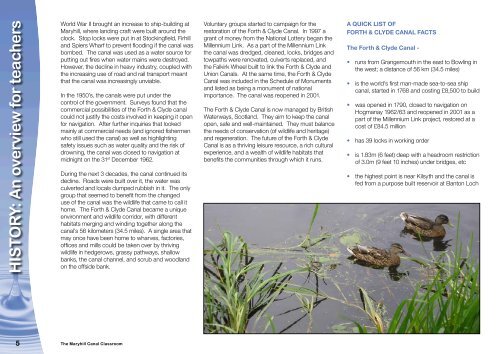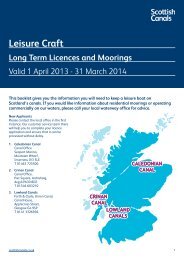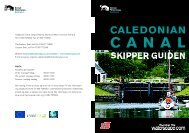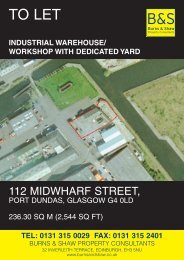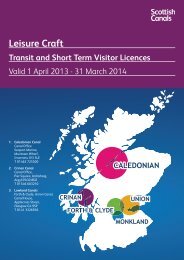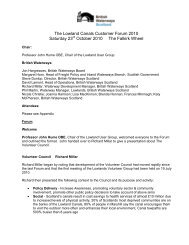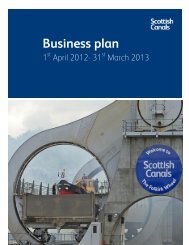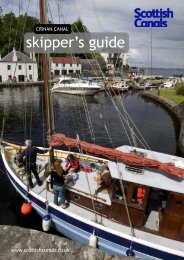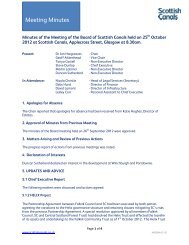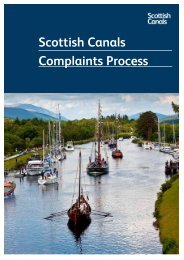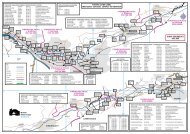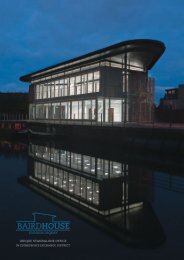Maryhill Canal Classroom - Scottish Canals
Maryhill Canal Classroom - Scottish Canals
Maryhill Canal Classroom - Scottish Canals
You also want an ePaper? Increase the reach of your titles
YUMPU automatically turns print PDFs into web optimized ePapers that Google loves.
HISTORY: An overview for teachers<br />
World War II brought an increase to ship-building at<br />
<strong>Maryhill</strong>, where landing craft were built around the<br />
clock. Stop locks were put in at Stockingfield, Firhill<br />
and Spiers Wharf to prevent flooding if the canal was<br />
bombed. The canal was used as a water source for<br />
putting out fires when water mains were destroyed.<br />
However, the decline in heavy industry, coupled with<br />
the increasing use of road and rail transport meant<br />
that the canal was increasingly unviable.<br />
In the 1950’s, the canals were put under the<br />
control of the government. Surveys found that the<br />
commercial possibilities of the Forth & Clyde canal<br />
could not justify the costs involved in keeping it open<br />
for navigation. After further inquiries that looked<br />
mainly at commercial needs (and ignored fishermen<br />
who still used the canal) as well as highlighting<br />
safety issues such as water quality and the risk of<br />
drowning, the canal was closed to navigation at<br />
midnight on the 31 st December 1962.<br />
During the next 3 decades, the canal continued its<br />
decline. Roads were built over it, the water was<br />
culverted and locals dumped rubbish in it. The only<br />
group that seemed to benefit from the changed<br />
use of the canal was the wildlife that came to call it<br />
home. The Forth & Clyde <strong>Canal</strong> became a unique<br />
environment and wildlife corridor, with different<br />
habitats merging and winding together along the<br />
canal’s 56 kilometers (34.5 miles). A single area that<br />
may once have been home to wharves, factories,<br />
offices and mills could be taken over by thriving<br />
wildlife in hedgerows, grassy pathways, shallow<br />
banks, the canal channel, and scrub and woodland<br />
on the offside bank.<br />
Voluntary groups started to campaign for the<br />
restoration of the Forth & Clyde <strong>Canal</strong>. In 1997 a<br />
grant of money from the National Lottery began the<br />
Millennium Link. As a part of the Millennium Link<br />
the canal was dredged, cleaned, locks, bridges and<br />
towpaths were renovated, culverts replaced, and<br />
the Falkirk Wheel built to link the Forth & Clyde and<br />
Union <strong>Canal</strong>s. At the same time, the Forth & Clyde<br />
<strong>Canal</strong> was included in the Schedule of Monuments<br />
and listed as being a monument of national<br />
importance. The canal was reopened in 2001.<br />
The Forth & Clyde <strong>Canal</strong> is now managed by British<br />
Waterways, Scotland. They aim to keep the canal<br />
open, safe and well-maintained. They must balance<br />
the needs of conservation (of wildlife and heritage)<br />
and regeneration. The future of the Forth & Clyde<br />
<strong>Canal</strong> is as a thriving leisure resource, a rich cultural<br />
experience, and a wealth of wildlife habitats that<br />
benefits the communities through which it runs.<br />
A QUICK LIST OF<br />
FORTH & CLYDE CANAL FACTS<br />
The Forth & Clyde <strong>Canal</strong> -<br />
• runs from Grangemouth in the east to Bowling in<br />
the west; a distance of 56 km (34.5 miles)<br />
• is the world's first man-made sea-to-sea ship<br />
canal, started in 1768 and costing £8,500 to build<br />
• was opened in 1790, closed to navigation on<br />
Hogmanay 1962/63 and reopened in 2001 as a<br />
part of the Millennium Link project, restored at a<br />
cost of £84.5 million<br />
• has 39 locks in working order<br />
• is 1.83m (6 feet) deep with a headroom restriction<br />
of 3.0m (9 feet 10 inches) under bridges, etc<br />
• the highest point is near Kilsyth and the canal is<br />
fed from a purpose built reservoir at Banton Loch<br />
5<br />
The <strong>Maryhill</strong> <strong>Canal</strong> <strong>Classroom</strong>


